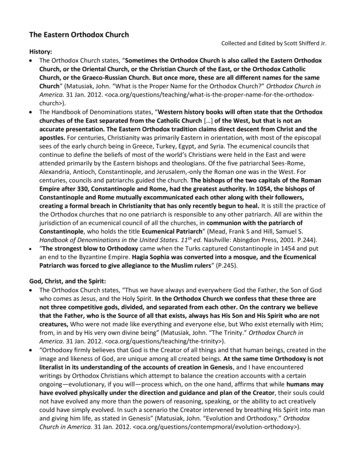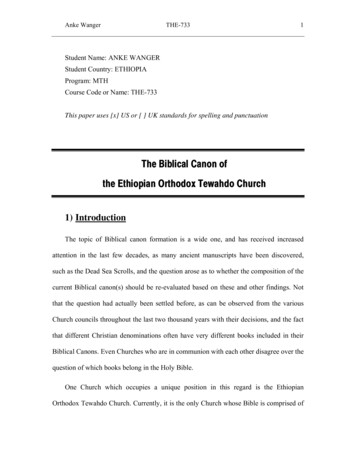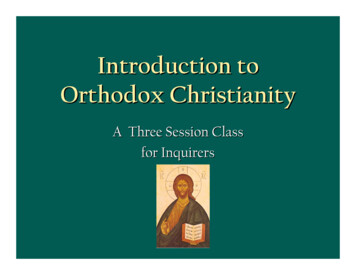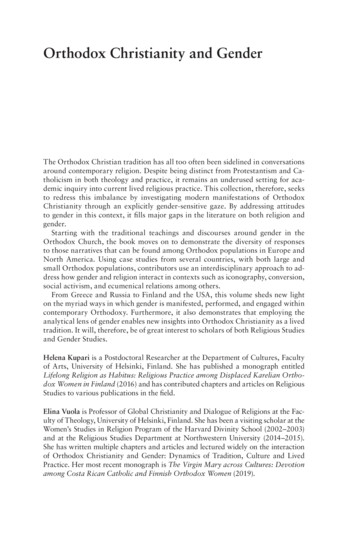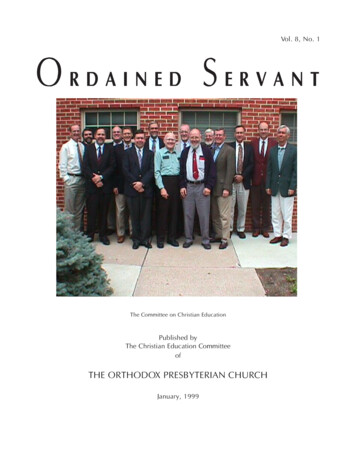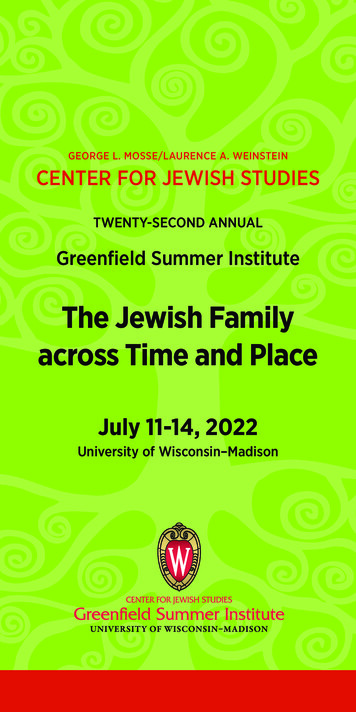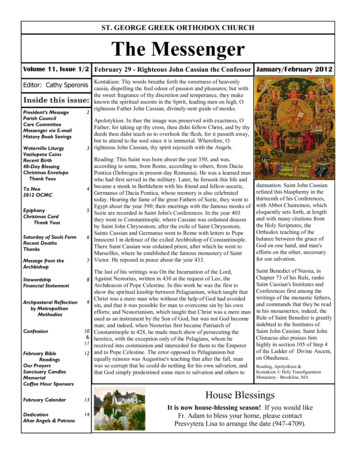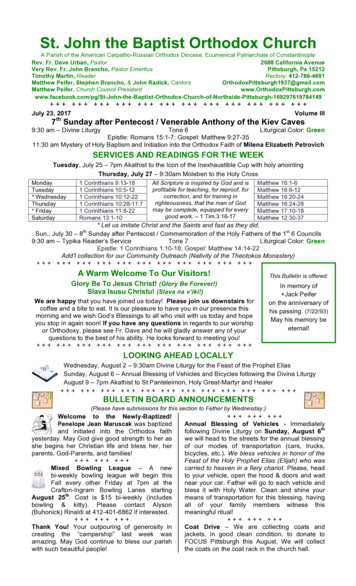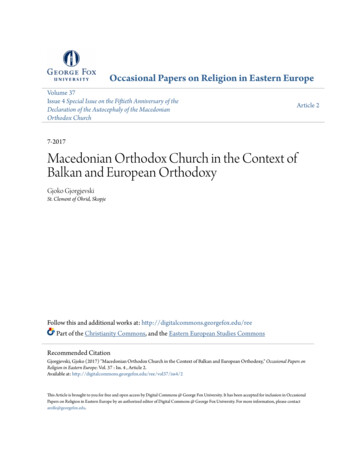
Transcription
Occasional Papers on Religion in Eastern EuropeVolume 37Issue 4 Special Issue on the Fiftieth Anniversary of theDeclaration of the Autocephaly of the MacedonianOrthodox ChurchArticle 27-2017Macedonian Orthodox Church in the Context ofBalkan and European OrthodoxyGjoko GjorgjevskiSt. Clement of Ohrid, SkopjeFollow this and additional works at: http://digitalcommons.georgefox.edu/reePart of the Christianity Commons, and the Eastern European Studies CommonsRecommended CitationGjorgjevski, Gjoko (2017) "Macedonian Orthodox Church in the Context of Balkan and European Orthodoxy," Occasional Papers onReligion in Eastern Europe: Vol. 37 : Iss. 4 , Article 2.Available at: /2This Article is brought to you for free and open access by Digital Commons @ George Fox University. It has been accepted for inclusion in OccasionalPapers on Religion in Eastern Europe by an authorized editor of Digital Commons @ George Fox University. For more information, please contactarolfe@georgefox.edu.
MACEDONIAN ORTHODOX CHURCH IN THE CONTEXT OF BALKAN ANDEUROPEAN ORTHODOXYBy Gjoko GjorgjevskiGjoko Gjorgjevski is a professor of Old Testament at the Faculty of Orthodox Theology “St.Clement of Ohrid” in Skopje of Ss. Cyril and Methodius University in Skopje. Since 2001, he isalso actively involved in the activities on interreligious dialogue. He is the former Ambassador tothe Holy See, 2010-2014.AbstractThe aim of this paper is to examine the recent history and actual position of the MacedonianOrthodox Church – Archbishopric of Ohrid (MOC-AO), which is still not accepted by theBalkan Orthodox churches. The relation between nation and church is also examined,recognizing it as one of the causes of the present situation of the MOC. The nature of this topicdictates to use and transmits various opinions and statements of prominent Orthodox leaders,scholars and theologians.Key words: Macedonian Orthodox Church, nation, ethnophyletism, autocephalyFor more detailed literature on this topic see – in Slavic languages: Славко Димевски, Црковна историја намакедонскиот народ, Скопје 1965 [Slavko Dimevski, Church History of the Macedonian People, Skopje 1965];Славко Димевски, Историја на Македонската православна црква, Скопје 1989 [Slavko Dimevski, History ofthe Macedonian Orthodox Church, Skopje 1989]; Доне Илиевски, Автокефалноста на Македонскатаправославна црква, Скопје 1972 [Done Ilievski, Autocephaly of the Macedonian Orthodox Church, Skopje 1972];Илија К. Марку, Македонска црква“ – Самотворевина Скопља. Улога Папе и Уније, Призрен 1994 [Ilija К.Marku, Macedonian Church“ – Self-creation of Skopje. The Role of the Pope and Union, Prizren 1994]; МиодрагПериќ, Историско-правните аспекти на односите помеѓу Српската православна црква и Македонскатаправославна црква, Скопје 1998 [Miodrag Perić, Historical-Legal Aspects of the Relations between the SerbianOrthodox Church and Macedonian Orthodox Church, Skopje 1998]; Предраг Пузовић, Раскол у Српскојправославној цркви – Македонско црквено питање, Београд 1997 [Predrag Puzović, Schism in the SerbianOrthodox Church – Macedonian Church Issue, Belgrade 1997]; Ђоко Слијепчевић, Македонско црквенопитање, Минхен, 1960 [Gjoko Slijepchevic, Macedonian Church Issue, Munich, 1960]; АлександарТрајановски, Бугарската егзархија и македонското националноослободително движење (1893–1908),Скопје 1982 [Aleksandar Trajanovski, The Bulgarian Exarchate and the Macedonian National LiberationMovement (1893–1908), Skopje 1982]; Александар Трајановски, Црковната организација во Македонија идвижењето за возобновување на Охридската архиепископија од крајот на XVIII и во текот на XIX век – доосновањето на ВМРО, Скопје 2001 [Aleksandar Trajanovski, Church Organization in Macedonia and theMovement for Restoration of Ohrid Archbishopric from the end of the XVIII century and during the XIX– until theestablishment of VMRO, Skopje 2001]. Михаил Витальевич Шкаровский, “Создание Македонской1OCCASIONAL PAPERS ON RELIGION IN EASTERN EUROPE (JULY 2017) XXXVII, 41
A Brief History of Orthodox Christianity in Macedonia1Christian life in the territory of the Republic of Macedonia was continuously present sinceearly Christian times. Since the first centuries, there have been Christian centers with bishop’sseats: Stobi, Heraclea, Bargala, Skupi, and others. In the ninth century, the most prominentamong the disciples of St. Cyril and Methodius, the brothers who created a Slavic alphabet, wereSt. Clement and St. Naum of Ohrid, who have continued their missionary activities in Ohrid.Naum, who was a monk, retreated to the south shore of the Ohrid Lake, where he built amonastery and formed a brotherhood; he is considered the founding father of the monasticism inMacedonia. St. Clement, instead, established a well-organized school in Ohrid, where in sevenyears, 3500 students were educated. Later, he was appointed bishop of the Dremvica and VelikaDiocese, the territory around the Ohrid Lake. This diocese soon grew into the OhridArchbishopric. This Church of Ohrid, as autocephalous, held jurisdiction over various territoriesduring different periods, sometimes even from the Danube and Dalmatia to the Black Sea andSicilia, but the seat was always in Ohrid, in the territory of Macedonia. Exactly 250 years ago, in1767, the Ottoman administration abolished the Ohrid Archbishopric and its dioceses were givento the Constantinopolitan Patriarchate. With its abolition, the Archbishopric of Ohrid provoked aПравославной Церкви в период оккупации республики и первые послевоенные годы”, Вестник ПСТГУ II.История . История Рускоҋ Православноҋ Церкви, II:3 32 (2009) 116-138. In other languages: Eastern Cristianityand Politics in the Twenty First Century, ed. Lucian. N. Leustean, New York 2014; Ivan Iveković, “Nationalism andthe Political Use and Abuse of Religion: The Politization of Orthodoxy, Catholicism and Islam” in YugoslavSuccessor States, Social Compas 49(4), 2002, 523–536; Aleksandar Panev, Orthodoxy, Modernity and Nationalityin Macedonia, 1800- A thesis submitted in conformity with the requirement for the Degree of Doctor of Philosophy,Graduate Dept. of History, University of Toronto; Ramet Pedro, Autocephaly and National Identity in Church-StateRelations in Eastern Christianity: An Introduction, in: Eastern Christianity and Politics in the Twentieth Century,Durham 1988; Victor Roudometof, “Nationalism, Globalization, Eastern Orthodoxy. ‘Unthinking’ the ‘Clash ofCivilizations’ in Southeastern Europe”, in European Journal of Social Theory 2:2, 1999; Charles WegenerSanderson, Autocephaly as a Function of Institutional Stability and Organizational Change in the Eastern OrthodoxChurch, Ph.D. Dissertation, Department of Government and Politics, 2005; Ronald Roberson, The Eastern ChristianChurches: A Brief Survey, Rome 1999; Jure Zečević-Božić, Die Autokephalieerklärung der MazedonischenOrthodoxen Kirche, Würzburg 1994.OCCASIONAL PAPERS ON RELIGION IN EASTERN EUROPE (JULY 2017) XXXVII, 42
deep impact not only on the ecclesiastical, but also on the civic history of that area, because, forcenturies, it was positioned between the most important institutions which left a strong imprinton the history and the destiny of the population on the Balkans,. As stated by Ivan Snegarov, “thehistory of the Church of Ohrid is a history of eight centuries of spiritual independence, I wouldsay, of the spiritual sovereignty of Macedonia. The autonomous spirit of Macedonia is not new,but was a product of its historical life. It was developed by the autocephalous church of Ohrid.“2In the nineteenth century, the Ottoman Empire, under international pressure, allowed thenational Orthodox churches of neighboring Bulgaria, Greece, and Serbia to work in various partsof Macedonia. During the Balkan Wars of 1912-1913 and during World War I, the territory ofpresent-day Macedonia came under Bulgarian rule; after the war, in 1920, it became a part of theKingdom of Yugoslavia wherein the renewed Serbian Orthodox Church took on the dioceses inthis part of Macedonia. This state of affairs lasted until 1941, when, after the beginning of theWorld War II, the Serbian hierarchy left Macedonia and the people and Bulgaria established thejurisdiction of the Bulgarian Church in the eastern part3, while a small part of western Macedoniafell under the jurisdiction of the Albanian Orthodox Church. These forced changes of foreignchurch jurisdiction provoked a revolt among the people and the native clergy, who decided not toever allow a church administration which is not of the Macedonian people. In 1943, on the firstliberated territory in Debarca, near Ohrid, at the Assembly held by the priests from that region,as well as at the Clergy-Laity Council held in 1945 in Skopje, a renewal of the OhridArchbishopric and an independent church were demanded.Иван Снегаров, История на Охридската архиепископия-патриаршия, т. 2, София 1995, VI [Ivan Snegarov,History of the Archbishopric of Ohrid, II, Sofia 1995, VI].3The presence of the Bulgarian Church is permanent in the country since its foundation in 1872, except the periodbetween the two world wars, when its clergy was forced to leave the territory of present-day Republic of Macedonia.The Bulgarian Exarchate was promulgated unilaterally; later in the same year from the Ecumenical Patriarchate itwas officially condemned by the Council in Constantinople as schismatic. The Orthodox Church in Bulgaria wasrecognized only in 1945 by the Ecumenical Patriarchate as autocephalous.2OCCASIONAL PAPERS ON RELIGION IN EASTERN EUROPE (JULY 2017) XXXVII, 43
At the Clergy-Laity Assembly held in Ohrid in October 1958 (attended by priests, monks,and faithful people), the Ohrid Archbishopric in the form of the Macedonian Orthodox Churchwas renewed and Bishop Dositej, vicar of the Serbian Patriarch, was elected the first Head of theChurch. The name “Macedonian Orthodox Church” was taken following the example of theother Orthodox churches. Immediately after this decision for the renewal of the OhridArchbishopric, the Council of the Serbian Orthodox Church, held in July 1959, concluded thatthe dioceses in the People's Republic of Macedonia had established an independent church andthe Constitution of the Serbian Orthodox Church was no longer valid for those dioceses and fortheir bishops. In July 1959, the Serbian Patriarch German visited Skopje and, together withArchbishop Dositej, ordained a second bishop for Macedonia, Clement, Metropolitan of Prespaand Bitola. In May 1962, accompanied by Patriarch German and other representatives of theSerbian Orthodox Church, Patriarch Alexis of Moscow visited Macedonia.In the period that followed, mutual understanding was missing: the Serbian OrthodoxChurch insisted on an autonomous status of the MOC, while the Macedonian Orthodox Churchdemanded complete independence, i.e. autocephaly. Thus, in 1967, at the Clergy-Laity Assemblyin Ohrid, the attendees voted to renew the Ohrid Archbishopric as an autocephalous MacedonianOrthodox Church.With the renewal of the Ohrid Archbishopric as the church of Macedonian people in thecountry and abroad, it started with organizing its church life, to establish its own educationalinstitutions—a Seminary and a Faculty, and to renew the monastic life. However, the oppositionof the Serbian Orthodox Church to the new reality officially isolated the Macedonian OrthodoxChurch from the other Orthodox churches. For all the subsequent efforts to gain recognition, theautocephaly of the Macedonian Church is not yet recognized by other Orthodox churches inOCCASIONAL PAPERS ON RELIGION IN EASTERN EUROPE (JULY 2017) XXXVII, 44
defense of Serbian opposition. Therefore, the Macedonian Orthodox Church has constantlyattempted to overcome this state of affairs. In these 45 years, commissions from both churcheshave met many times, but after all the meetings and discussions, no solution has been reached,neither for its status, nor for its name, which appears one of the biggest obstacles from the side ofthe Greek Orthodox Churches. It is evident that this situation is further complicated by thecontemporary political situation in which Macedonia found itself, most of all, the nonrecognition of the name of the country.After the several meetings at the end of the twentieth and the beginning of the twentyfirst centuries, in 2002 in the Serbian city of Niš, Macedonian and Serbian Orthodox Churchofficials met to discuss the status of the Macedonian Church. The Macedonian side was asked tosign an agreement that would downgrade the Macedonian Church to an autonomous body withinthe Serbian Orthodox Church and the Macedonian Church would be renamed the Archbishopricof Ohrid. This proposal was unanimously rejected by the Macedonian Synod and theMacedonian people. But, one of the bishops of MOC, Metropolitan Jovan (Vranishkovski) ofPovardarie,4 had crossed over to the Serbian Orthodox Church, which used his departure toappoint him as “exarch of the Serbian Orthodox Church in Macedonia” (at that time, Jovan wasalready accused in Macedonia for canonical offences and criminal activities). With a decision ofthe Archierarchs’ Bishops’ Council of the Serbian Orthodox Church on 24 May 2003, a parallelSynod of the Serbian Church for Macedonia was formed, led by Jovan, with the election of twonew bishops, one of them being only 25 years of age. The Serbian Orthodox Church inAt 24.06.1998, by the Decision of the Holy Bishops’ Synod of the Macedonian Orthodox Church Jovan(Vraniskovski) was elected for a vicar of the Diocese of Prespa and Pelagonija with the title bishop of Dremvica.Since 08.03.2000 he became Administrator of the Diocese of Bregalnica. Few mounts later, at 15.11.2000, he wasremoved as the administrator of Bregalnica and appointed to the Diocese of Povardarie. In June 2002 he left theMacedonian Orthodox Church.4OCCASIONAL PAPERS ON RELIGION IN EASTERN EUROPE (JULY 2017) XXXVII, 45
Macedonia (“Orthodox Archbishopric of Ohrid” - OAO) is still not registered in Macedonia as areligious community nor does it have legal status.5In 2004, the Macedonian Parliament adopted a declaration that supported the MacedonianOrthodox Church, all efforts and decisions made by the Macedonian Synod, as well as itscommitment to preserving its integrity, significant status, and role in the social life of thecountry.On November 2009, the Macedonian Orthodox Church at its regular Clergy-LaityAssembly, changed the Constitution and added to its name the title “Archbishopric of Ohrid"with the Church being officially titled “Macedonian Orthodox Church – Archbishopric ofOhrid.”National Identity as a Stumbling Block for Balkan and Macedonian OrthodoxyThe joyous message of salvation, carried by Apostle Paul, rapidly reached Europe. Thiswas not a coincidence. He was invited by a European, who begged him to “come over toMacedonia” and help him and his people (Acts, 16:9); it was a vision that revealed a new reality,a vision that has given direction to the course of Christianity. Paul’s first step in the Balkansmarked the beginning of Christianity in Europe. Centuries later, Christian Balkans took a newphysiognomy by the arrival of Slavs. However, the Orthodox people of all of Southeast Europewould share the same or similar destiny for a long period of time, first being within Byzantium,and then following a few centuries of joint life in the Ottoman Empire. Since that time, numerousspiritual and cultural treasures were handed down to us as an inheritance. The small churches andmonasteries became centers and spiritual hearths. Most of them, built during various periods,5According to the present Law on the Legal Status of a Church, Religious Community and a Religious Group, art.10: “The name and official insignia of each new church, religious community and religious group shall be differentOCCASIONAL PAPERS ON RELIGION IN EASTERN EUROPE (JULY 2017) XXXVII, 46
have been completely preserved up to today. Apart from the valuable fresco painting, due towhich the Balkan schools are renowned in the world, the monasteries hid in their ancienttreasuries invisible records of the spiritual code of the monastic struggle that took place in there.So, this part of Europe, the Balkans, possesses a huge common spiritual and culturalinheritance—although, most often, it is not about huge deeds and constructions, which do notdecrease their value at all. As a poet recorded: in the past, maybe we had no colossal churches,but from our soul, we have created a dwelling for God; now, we are building magnificenttemples, but our souls appear to remain vain.All of these challenges introduce us to the periods of the nineteenth and twentieth centuries,when most Balkan peoples succeeded to become free and to establish their own states. Thisallowed them to organize themselves regarding the church as well, and to establish their ownindependent churches with emphasized national character. But these alterations seemed to alsoinfluence the Orthodox cohesion, and Orthodox unity and unanimity, darkening the image of theuniversal character of the Church and its ecumenical mission. Has national reductionismnarrowed the role of the Church to a mere identification with the nation and the national interest?How could we define “ethnophiletism,” condemned by the Church, but usually used as anargument by the “mother” churches, disappointed, unsatisfied (but also angry) by the selfinitiated departure of the “daughter” churches?For the Patriarchate of Constantinople, ethnophyletism is devastating and catastrophic,especially for the Balkan area. At the official page of the Patriarchate remains thatethnophyletism is “a product of the Enlightenment and the French revolution. It was a newpolitical theory, on the basis of which were created the nation states of Europe, and, in particular,those of the Balkan Peninsula.” In that sense, the “states were now formed according to thisfrom the names and official insignia of already registered churches, religious communities and religious groups.”OCCASIONAL PAPERS ON RELIGION IN EASTERN EUROPE (JULY 2017) XXXVII, 47
dominant theory, on the basis of ethnophyletic criteria—either those already in existence or,mainly, those invented by means of politics or propaganda” (it is an interesting observation,because nowadays some of those nation are firmly claiming the same for the smaller neighboringnations, including Macedonia). It is noted that “this theory is, alas, still being applied in theBalkans today, with its familiar disastrous consequences on the lives of the people of the regionand on peace.” Consequently, one of the “most significant points of evolution” was “the creationof national churches which, for a certain time were alienated from each other.” Conforming tothis statement, all Balkan churches were projects of foreign propaganda: “Those who wereinformed by this spirit of ethnophyletism collaborated with foreign political powers and weremoved to declare the arbitrary autocephaly of churches in Greece (1833), Rоmania (1865),Bulgaria (1870) and Albania (1922-1928-1937).” Subsequently, the Ecumenical Patriarchateadopted a position against this phenomenon. “Initially, it censured the Greeks (1833-1850) andthen, at the Great Local Synod in Constantinople (1872), went on to condemn ethnophyletism,which was not merely a deviation from the healthy love of one’s nation and state, but constitutesa real impediment to cooperation between local Orthodox Churches in the world and is thegreatest enemy to the unity of the Church.”6 According to these words, the ethnophyletism in thenational churches is not a phenomenon of the past, but it is a present danger that is hurting theunity of the Orthodox Church.The problem of the relation of the nation and the church (especially) in the Balkans is stillan inflammable issue to which different answers are given; however, it seems that often thePanteleimon Rodopoulos, “Territorial Jurisdiction According to Orthodox Canon Law. The Phenomenon ofEthnophyletism in Recent Years”, n-of-ethnophyletism-in-recent-yea-1. The article is published also in Territorialità epersonalità nel diritto canonico: il diritto canonico di fronte al terzo millenio: atti dell' 11. Congressointernazionale di diritto canonico e del 15. congresso internazionale della società per il diritto delle chieseorientali, Budapest 2-7 settembre 2001.ed. Peter Erdo - Peter Szabo.6OCCASIONAL PAPERS ON RELIGION IN EASTERN EUROPE (JULY 2017) XXXVII, 48
theology and ecclesiology doesn’t have the required position in directing and forming of thechurch attitudes and actions. What is the role of the national identity in the life of the OrthodoxChurch? Is it possible to separate national consciousness from religious belief?According to Stefan Tzankov, “the nation may be a bearer of the good and bad, of thedivine and of the demonic, of the virtue and of the sin, of the love and of the hate, of theharmony and of the discord. If it is the case of the latter, then the Church has in the nation ananti-Christian power which, just like an evil mother, wants to destroy and swallow her children,who considers herself to be something special, or a center and the biggest wealth of the world .who operates the passions . hatred, hostility . the power which guides to self-conceit.”7The link between the local church and the national identity is evident, especially by theBalkan Orthodox churches. And moreover, the church is often considered the protector of anation or the ground for the state’s unity and even its endurance. In the words of PatriarchTeoctist, “the history of Romanian people is intertwined with the history of the OrthodoxChurch, the only institution which has lasted since the birth of the [Romanian] people. Whoeverdenies that the church is the national church should deny the unitary character of the Romanianstate.”8For the former Archbishop of the Greek Orthodox Church, Christodulos, the Church is alsoa guardian of the nation, when he says: “(The role of the Church is not and must not be incompetition with the State). Preserving our national identity, the Church helps our State in selfunderstanding that is a factor of strength and spontaneity Only here, in our country, theconcern for the salvation of our distinctiveness is considered as anti-European, nationalistic,Стефан Цанков, „Црква и нација на православном Истоку“, Хришћанство и политика, Шабац 1998, 96-97[Stefan Tzankov, “Church and Nation in the Orthodox East“, Christianity and Politics, Šabac 1998, 96-97].8Alfred Stepan, ‘‘Religion, Democracy and the ‘Twin Tolerations’’’ Journal of Democracy 11, 4 (2000): 39–40;Lavinia Stan and Lucian Turcescu, Religion and Politics in Post-Communist Romania, (Oxford: 2007), 30.7OCCASIONAL PAPERS ON RELIGION IN EASTERN EUROPE (JULY 2017) XXXVII, 49
pessimistic, conservative, and many times criticized as being behind the times, or even a fascistplot. Nevertheless, here in our country the meaning of nation is all-powerful and has the strengthto survive.”9Analyzing the situation in their own churches, same scholars are realizing that “the Churchin Greece seems unable to escape the syndrome of identifying with the nation. It is unable to seeits work and its general historical course as distinct from the course of the nation. It also appearsto remain unaware of the fact that this identification with the nation and national ideology hasbeen imposed on the Church by the state, to serve the state's own purposes, which gradually havebecome the Church's purpose, too.”10 The attempt of the Church to give its contribution to the“struggles of the nation,” in order to guard its exclusive relationship and symbiosis with theethnos is also observed. “As the Greek state is gradually denationalized, as a result of the widerrealignments due to globalization and multiculturalism, the Church in Greece is moreemphatically nationalized, because of a growing sense of insecurity that results from the loss ofthe special legal relationship to the state and the exclusive relationship with the nation.”11 It is abig challenge, but also a strong temptation for the Church.12 But, on the other hand, it should be aArchbishop Christodulos, „The Word and Role of Orthodoxy in the European Union“, /christodoulos speeches.asp?cat id &id 485&what main 3&what sub 12&lang en&archbishop heading Addresses/Speeches10Panteleimon Kalaitzidis, „The Temptation of Judas: Church and National Identities“, Greek Orthodox TheologicalReview 47, 1-4, 2002: 365. For the history of the adoption of the national ideology by the Church of Greece, see alsoC. Frazee, The Orthodox Church and Independent Greece (1821-1852), (Cambridge 1969). For a comparative studyof this phenomenon in the Balkan countries, see P. Kitromilidis, “'Imagined Communities' and the Origins of theNational Question in the Balkans,” in Modem Greece: Nationalism and Nationality, ed. M. Veremis; (London andAthens, 1990), 51-60.11A. Manitakis, The Relations between the Church and the State-Nation in the Shadow of the Identity-CardsConflict, (Athens, 2000), 17.12“Indeed, the temptations that Christ rejected in the wilderness appear acceptable to the institutional Church. Thereis a difference: instead of transforming stones into bread, the Church flirts with both: attempting to show thatMacedonia is Greek, and organizing massive gatherings to demand the inclusion of religious denomination onidentity cards.” Panteleimon Kalaitzidis, „The Temptation of Judas: Church and National Identities,” 367.9OCCASIONAL PAPERS ON RELIGION IN EASTERN EUROPE (JULY 2017) XXXVII, 410
case of worry when theologians start to assert that the authentic nationalism is a God-given gift,which should be appreciated, because not all people derive from a true and authentic nation.13In this context of strong religious-national liaison in the neighboring’s counties, theMacedonian Orthodox Church appears as a restored Archbishopric of Ohrid, as was previouslysaid, for the first time as an autonomous church within the Serbian Orthodox Church in 1958,and then by a decision of the Assembly in 1963 with proclaimed autocephaly. Both the first andthe second acts remain suppressed and the situation is being ignored by the remaining Orthodoxecumena, deciding to leave it as an unsolved internal issue of the Serbian Orthodox Church. Itcould be said that this local Church follows the path to independence of the rest of the Balkansand other local churches, and it doesn't deviate from it, even in originally not being givenpermission for independence from the “mother-church” (virtually all of the national churchesexisted as autocephalous first and were recognized as such only “after the fact”). But, the maindifference is that all other Balkan churches self-declared and achieved their independence fromthe Patriarchate of Constantinople, which, although predominantly Greek, was composed ofdifferent nations and cultures, that probably permitted a decent equilibrium between them, whiledecades later, it appears that the Macedonian Orthodox Church, in an ambient of dense nationalconcentration, that (as was realized in recent history) does not permit dignified space fordifferent large national group of believers.13Who respects his nation and firstly deals with the nation and proper commitment to the nation (as something givenby God) and, of course, its quality of contributing to humanity--is nationalist. “Great America, enriched in wars butalso through the efforts of its citizens is proud of its hybrid national identity, and Serbia is hiding her faith and itsorganic nationalism during the most difficult moments. Partly on the basis of “guidelines” which come from thesame America Serbian nationalism is associated with Orthodoxy, with its evangelical roots of St. Sava. TrueSerbian nationalism is not hateful and exclusive but based on the meaning and purpose of the historical way of thenation. As obligation. On the common Testament.”Ђакон Ненад Илић, “О Цркви и националном –америчка размишљања”[Deacon Nenad Ilic, “About the Church and National – American и-националном/OCCASIONAL PAPERS ON RELIGION IN EASTERN EUROPE (JULY 2017) XXXVII, 411
The national and state politics of some of the surrounding countries have deeply influencedthe attitude of related churches in their strong opposition of the existence of one “Macedonian”church. Its problem is connected also to the problem of challenging its right to use thedesignation by which the state's and the nation's name is marked. For Orthodox believers, thisattitude is difficult to understand, posing the questions: could a bad name exist for a church ofGod? Do evangelical and canonical bases exist upon which it is possible, from the position of theChurch, to ask from the other to renounce his identity, even it is a national one? As a conditionfor acceptance, can being forced into national apostasy be defined as a struggle against theethnophyletism or nationalism? Is it possible to identify some unusual “sinful” relationshipbetween the church and the nation in Macedonia, which is very different from all other Orthodoxchurches and countries?The connection with the Archbishopric of Ohrid is often placed in evidence in the contextof restoration as the Macedonian Orthodox Church. As a historical argument, it has its ownimportance, but the historical evidence has much more weight. Also, non-Macedonian scholarsand experts openly remember the role of foreign ecclesiastical jurisdiction in the Macedonianterritory for the purpose of implementation of a national-state policy.14 Therefore, an experienceof suffering by the political misuse of the church for the purpose of denationalization andassimilation in the past
Clement of Ohrid" in Skopje of Ss. Cyril and Methodius University in Skopje. Since 2001, he is also actively involved in the activities on interreligious dialogue. He is the former Ambassador to the Holy See, 2010-2014. Abstract The aim of this paper is to examine the recent history and actual position of the Macedonian


